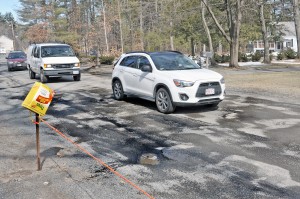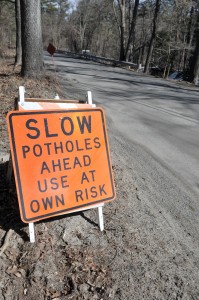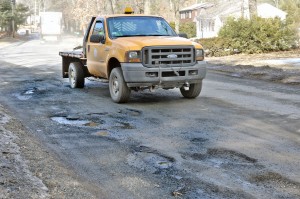
A bright orange piece of rope protects the front lawn of Patty Hebert after drivers were using the lawn to avoid the potholes. (Photo by Frederick Gore)
WESTFIELD – Patty Hebert is a very patient woman. She has to be.
After all, Hebert runs a daycare center at her home on Shaker Road in Westfield, and has been doing so for the past decade. But it’s never been this bad.
“This is the worst,” she said. “And it’s so bad that my husband had to put up a rope, because people were driving on our lawn to avoid them.”
By “them” she is of course referring to the potholes which have formed on the road in front of her home, some deep enough to engulf an entire wheel of a vehicle.
Hebert’s yard is littered with gravel that has been pelted into the earth by passing cars, gravel that the city’s highway department has twice used to fill and refill the troublesome holes, to no avail.
“It’s bad because you literally hear people fighting in the street because one person is going too slow because they don’t want to hit the potholes,” she said. “And they’ll yell at each other. It’s crazy. And at night, you can’t sleep because if a truck that’s towing something drives by, everything vibrates. It’s awful.”
The Shaker Hill resident is hoping that the city’s DPW will fix her lawn in the spring, which Mayor Daniel M. Knapik said will happen if she has gone through the necessary channels.

A large reflective sign warns drives to use a portion of Shaker Road in Westfield at their own risk after large potholes have been reported citywide. (Photo by Frederick Gore)
“They’re up there (Shaker Road) working today,” said Knapik this morning. “If she’s filed a complaint online, and she’s called the DW, they’ll be able to get to it in the spring.”
“I did call (the city) once and said ‘someone is going to get hurt,'” Hebert said. “But instead of doing anything about it, they put signs on the ends of Shaker Road that said ‘Pass at your own risk.'”
“We pay excise taxes, real estate taxes, and they put up signs,” she continued. “They need to pick up the whole street and repave it, because this is ridiculous. It is absolutely ridiculous.”
Knapik has stated that many streets around the city are set to undergo big makeovers within the coming years, but the wheels of government and funding turn slowly.
“A lot of cities and towns pursue state funding and then go through with their design projects, but we’ve taken a different approach by designing projects and then pursuing state funding. So we spend a little money but we’ve never been turned down for funding,” Knapik said.
“We’ve commissioned design work for Clay Hill, and we’ll start to bid that out this summer, and Route 10 will start soon as well.”
Knapik also mentioned Court Street, East Mountain Road, West Silver Street, and Western Avenue as arteries that are set for reconstruction, but said that these projects could be about five years away.
“No, because I’ve had these people for a very long time,” Hebert said, when asked if her business was being impacted. “But every single one of them has complained about it and said ‘What’re you going to do? Are you going to call somebody?’ Well, I called twice and they came out and fixed it twice.”
Hebert was also under the impression that the city owned a machine for the specific purpose of eliminating potholes.
“Didn’t Westfield buy something to fix potholes?” she said. “I think they bought something to use in weather like this when the tar plants aren’t open.”
Asked as to whether she has been able to speak with Jim Mulvenna, the City of Westfield’s director of Public Works, Hebert said no.
“Nobody answers, so I have to leave messages,” she said. “Each time that I’ve left a message, within two days, they’ve been out to put gravel in it, so they obviously are getting my messages. But the last time when I said ‘somebody is going to get hurt’, the next day they had those signs out, to cover themselves.”

The rear wheel of a city-owned vehicle slams into a pothole on Shaker Road in Westfield yesterday. (Photo by Frederick Gore)
While city residents may get into the habit of assuming their potholes are the worst in recorded human history, Knapik reiterates that the pothole issue is a regional issue, not just here in Westfield, and that the state’s continued cuts to Chapter 90 funding, combined with the city’s focus on acquiring funds for bridge construction, have ensured that the problem will continue to be a persistent one.
“Part of the problem, and it’s not anyone’s fault, is that a lot of effort has been put into bridge funding (in Westfield),” he said. “But the state has gotten in a habit of just doing overlays, and it’s a problem all over the Commonwealth.”
“We did a study in 2002, and we found that it would cost $2 million to keep doing overlays,” he said. “Pavement was $35 a ton back then, and our Chapter 90 reimbursement was about $500,000. Pavement’s probably closer to $80 or $90 now. It would probably cost us $4 million to do the overlays today.”
For now, though, it’s a game of wait and see for residents like Patty Hebert, who will now wait for warmer weather and with it, the start of paving season.
“If you stand here and just watch (the road), it’s almost better than watching TV,” she said sarcastically. “You get a lot of kids driving home from the high school, and they don’t pay attention, so if you drive down Shaker Road, you’ll probably see a few rims (on the side of the road). If you stay out her long enough, it’s quite the show.”

